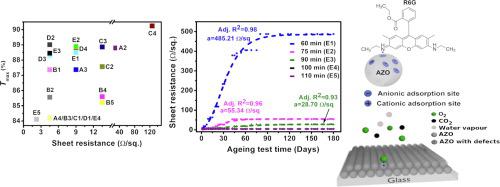Journal of Colloid and Interface Science ( IF 9.9 ) Pub Date : 2020-09-03 , DOI: 10.1016/j.jcis.2020.08.092 Jnanraj Borah 1 , Bimal K Sarma 1

|
In this work, an attempt has been made to produce high quality Al-doped ZnO (AZO) transparent conductors by pulsed direct current (DC) magnetron sputtering under varied process conditions, namely sputtering power, sputtering pressure, doping level, and deposition time. The idea is to develop stable AZO films with excellent electro-optical properties, which can replace indium tin oxide (ITO) as transparent conducting oxide. The films are deposited on glass and polyethylene terephthalate (PET) substrates and characterized by X-ray diffraction (XRD), Raman spectroscopy, field emission scanning electron microscopy (FESEM), and energy dispersive X-ray spectroscopy (EDS) for material properties. The electronic and optical properties are investigated using UV–Vis-NIR absorption spectroscopy, photoluminescence spectroscopy, four probe resistivity and Hall measurements, which facilitate the design strategy to achieve promising electro-optical properties. AZO films under optimized process conditions possess sheet resistance below 5 Ω/sq. and maximum visible light transmittance close to 90%. The lowest value of electrical resistivity is found to be 2.1 × 10−4 Ω·cm. The combination of low electrical resistivity and high optical transparency leading to the figure of merit of the order of 10−2 Ω−1 is critically dependent on the process conditions of sputtering as well as doping contents. High free carrier concentration in AZO films leads to the Burstein-Moss shift and this observed blue shift of the absorption spectrum as compared to that of ZnO with native defects depends on the doping contents and the process conditions. This work further explores the role of interface chemistry to achieve high stability of AZO films under ambient oxidizing conditions. The adsorption kinetics of cationic rhodamine 6G and anionic methyl orange at AZO surface with varying adsorption sites and ageing studies on the sheet resistance reveal that the excellent stability of AZO films is delicately linked to the process conditions as well as the content of the dopant material used in the preparation of the AZO sputtering targets. The findings of the study confirm that the sheet resistances of selective AZO films undergo no change and fixed at 4.5 Ω/sq. even for ageing period of over six months.
中文翻译:

老化稳定的AZO薄膜作为高质量透明导电氧化物的设计策略和界面化学。
在这项工作中,已经尝试通过脉冲直流(DC)磁控管溅射在各种工艺条件下(即溅射功率,溅射压力,掺杂水平和沉积时间)生产高质量的Al掺杂ZnO(AZO)透明导体。这个想法是要开发出具有优异电光性能的稳定AZO薄膜,该薄膜可以代替铟锡氧化物(ITO)作为透明导电氧化物。薄膜沉积在玻璃和聚对苯二甲酸乙二醇酯(PET)基板上,并通过X射线衍射(XRD),拉曼光谱,场发射扫描电子显微镜(FESEM)和能量色散X射线光谱(EDS)表征材料的性能。电子和光学特性使用UV-Vis-NIR吸收光谱,光致发光光谱,四个探针电阻率和霍尔测量,这有助于设计策略实现有希望的电光特性。在优化的工艺条件下,AZO薄膜的薄层电阻低于5Ω/ sq。最大可见光透射率接近90%。电阻率的最低值是2.1×10-4 Ω·cm以下。低电阻率和高的光学透明度的导致10的顺序的品质因数的组合-2 Ω -1取决于溅射的工艺条件以及掺杂含量。AZO膜中的高自由载流子浓度导致Burstein-Moss位移,并且与具有天然缺陷的ZnO相比,观察到的吸收光谱的蓝移取决于掺杂含量和工艺条件。这项工作进一步探讨了界面化学在环境氧化条件下实现AZO膜高稳定性的作用。阳离子若丹明6G和阴离子甲基橙在AZO表面上的吸附动力学以及不同的吸附位置以及对薄层电阻的老化研究表明,AZO膜的优异稳定性与工艺条件以及所用掺杂剂含量密切相关在制备AZO溅射靶时。研究结果证实,选择性AZO薄膜的薄层电阻没有变化,固定在4.5Ω/ sq。甚至超过六个月的老化期。


























 京公网安备 11010802027423号
京公网安备 11010802027423号